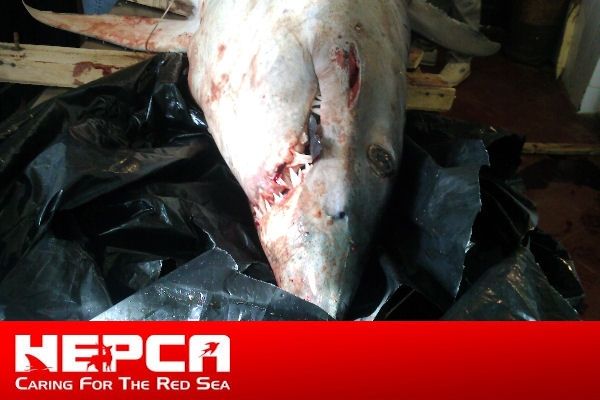From Hysteria to Absurdity: The Saga continues
Authorities in Sharm El Sheikh continue to find new ways to demonstrate their ecological ignorance with the planned construction of shark exclusion nets around beaches in Sharm El Sheikh. The operation to protect tourism in South Sinai in the wake of the shark attacks of November and December 2010 has been plagued by knee-jerk reactions, lack of communication and almost comedic activities. Longlines were set for ten days after the attacks and their baited hooks probably attracted many additional sharks to the area (many of which will have perished on the very same lines). The South Sinai Protectorate (SSP) were quick to defend their actions, describing the indiscriminate killing of sharks as an “internationally recognised process of ‘shark assessment’.” Since this ‘shark assessment’ requires the ‘scientists’ involved to view shark innards all the captured specimens are killed. When an SSP senior official was interviewed by Al Masri Al Youm he didn’t “have the exact figures of how many sharks were assessed” (for assessed read butchered), but was certain that they were “doing everything scientifically, and the numbers indicate our waters have a surplus of sharks”. It is incredible that science has advanced to such a degree that we can know from ten days of staring at shark entrails that there is a surplus of the endangered species here in the Egyptian Red Sea. In addition to the well-publicised criminal long-lining activities, so-called scientists sought to attract “man-eating sharks” by stuffing a black neoprene wetsuit with sawdust and leaving it in the water close to an attack site. When this ingenious plan failed it was enhanced by using a mannequin, complete with swimwear and sunscreen (and hooks to catch any creature that was stupid enough to approach). The mannequin unsurprisingly fell apart while being dragged behind a boat (of course a shark attack was blamed). Several experts were invited to Sharm El Sheikh to investigate the attacks. They largely kept away from the media, with one noticeable exception. The larger than life Mr. George Burgess, a contentious figure in shark research, took every opportunity to speak to the media and seemed content to vindicate the position and actions of the authorities at every moment, whilst selectively utilising the work of other scientists. In his personal summary of events he talks of the final press conference of his visit being “his last big chance at “self promotion” and he certainly grabbed his chance with both hands. Now, with the blessing of Mr. Burgess, there are plans afoot to construct shark exclusion nets around beaches in the Sharm El Sheikh area (indeed companies have already started tendering for the work). Whilst we are promised that gill nets (which are designed to catch sharks and other species of a particular size) will not be used, any kind of netting will have a direct and devastating impact on the local marine ecosystem. A very fine exclusion net will stop any creatures passing and halts the movement of grazers and predators (which are essential to reef ecosystems) in and out of the netted area. When “aziab” (south wind) conditions come to South Sinai the nets will most likely become a tangled mess of nylon,steel and marine life adorning the reef. A preliminary report by other scientists invited to advice authorities in the aftermath of the attacks (Marie Levine, Ralph Collier, Mustafa Fouda, Mohamed Salem, Nasr Galal, Leonard Compagno and Erich Ritter) discouraged the use of nets; describing them as expensive and high maintenance, as well as warning that they could encourage sharks to be present in the area. The nets offer a swimming pool in the sea - for tourists who want a swimming pool, every hotel in Sharm El Sheikh offers this amenity. If we are determined to build barriers between tourists and “dangerous marine life” maybe 6 metre high fences along the beach to protect the marine environment from irresponsible tourism might be a more sustainable option. If the nets are installed, HEPCA will offer dive professionals 100LE for every metre of netting that is “cleaned” from the beaches. Together we can protect our marine environment. When we bathe, swim, snorkel or dive in the Red Sea we are visitors in the habitat of marine creatures. There will never be a zero probability of being attacked by a shark (at least not until they become extinct), but the chance is already ridiculously small. Globally, 376,000 people drowned in 2006; 4 people died in the same year due to sharks. A recent New York Times article sums it up well “you have double the chance of dying from a coconut falling on your head” than being killed by a shark. It is time to end the hysteria and for common sense to prevail in Sharm El Sheikh. We don’t need nets and watchtowers, simply the basic education of tourists. Let people learn more about the marine environment and understand the risks before they enter the water. Sharks are top predators and therefore of critical importance to our treasured Red Sea ecosystem, let's do everything in our power to protect them.



